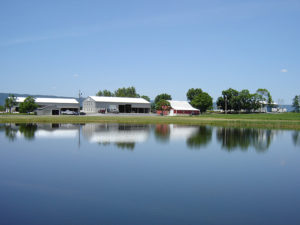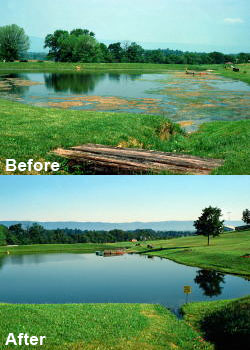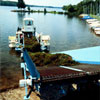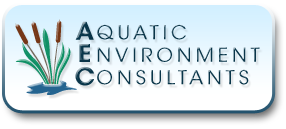Aquatic Vegetation Management

Problems Caused By Excessive Vegetation
While the right types of vegetation are essential for maintaining a healthy, balanced ecosystem in your lake or pond, too much vegetation can cause harm. A lack of aquatic plant management can allow vegetation to quickly overwhelm your water body. Excess vegetation makes it easy for small fish to hide from larger predator fish, resulting in a fishery that is out of balance with the aquatic ecosystem. Without effective aquatic plant management techniques, excessive vegetation can also result in the over-absorption of oxygen, leading to fish kills in the summer or winter months. Finally, if you use your water body for recreational purposes, excessive vegetation can hinder activities such as swimming, boating or fishing.
We Provide Aquatic Vegetation Management in the Four Key Categories

- Mechanical: Mechanical interventions can be an effective form of short-term pond and lake weed control. Mechanical interventions typically involve the use of rakes, seines, nets, harvesters and other devices to remove nuisance plants.
- Biological: Biological aquatic plant management is achieved through the introduction of fish and insects that naturally prey on algae and other invasive species. Care must be taken when using biological interventions as a form of pond weed control, so you don’t upset the delicate balance of the ecosystem.
- Physical: Maintaining proper oxygen levels is an important part of aquatic vegetation control. Installing a diffused aeration system or other device that physically adds oxygen to lake water can be useful in managing algae levels and the growth of nuisance vegetation.
- Aquatic Herbicides and Algaecides: Herbicides and algaecides can be effective at stopping algae blooms and other invasive growths in your lake and pond. However, the introduction of any product to an aquatic ecosystem should be done with extreme caution — and only after consulting with an experienced aquatic control specialist.
At AEC, we understand that there is no one method of vegetation control that works for every body of water. We use our years of experience to determine the best method or combination of methods for your unique situation. We then develop a long-term management program that will maintain your water body for years to come.
Vegetation Monitoring
Ongoing monitoring of algae and plant populations in your lake or pond is the best method of preventing excessive growth. It will also help you avoid the need for drastic interventions. By establishing a baseline for water quality, fish populations and plant populations, it’s possible to monitor changes over time and anticipate when proactive maintenance is required.
Ultimately, this is the best way to control the growth of aquatic weeds and maintain a healthy, balanced ecosystem in your lake or pond.
Plant and Algae Species Vegetation Control Options
With so many different species of plants and algae, it can be a challenge to determine which ones are growing in your water body and how to manage them. We can help in the identification process and determining the best control and management options!
1Grass Carp

2Herbicide Control

3Mechanical Harvester

4Pond Dye

Why Choose AEC for Aquatic Vegetation Control?
AEC has been helping residential and commercial property owners with their aquatic vegetation management needs since 1987. By implementing the appropriate physical, biological, mechanical or herbicide/algaecide control technique for your water body, our experienced and knowledgeable team of water management professionals will help you maintain a healthy vegetation balance and enhance your pond or lake’s aesthetic appeal. Whether you need assistance with algae reduction or pond or lake weed control, AEC will help you meet and exceed your aquatic vegetation control expectations!
